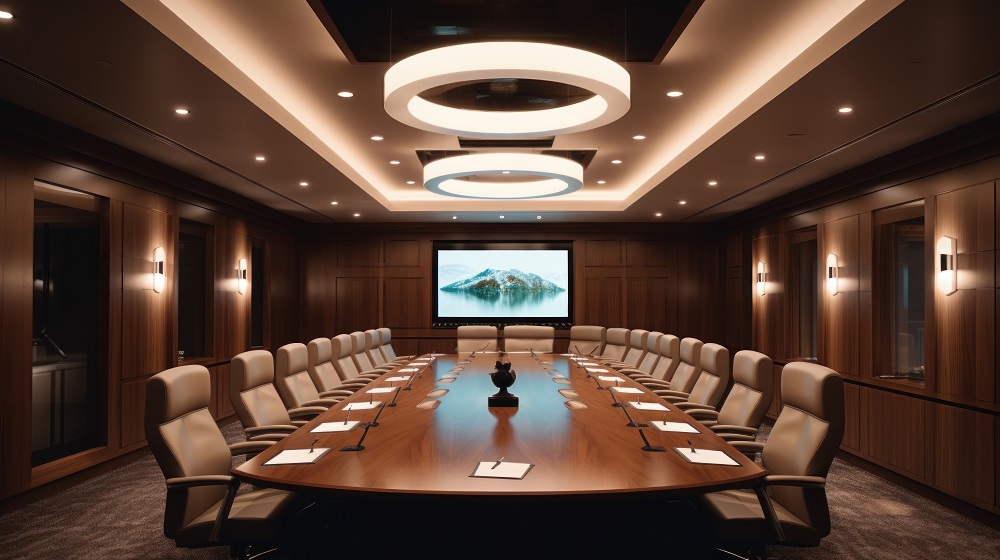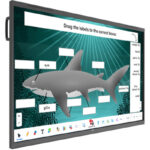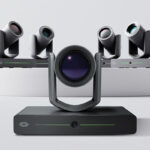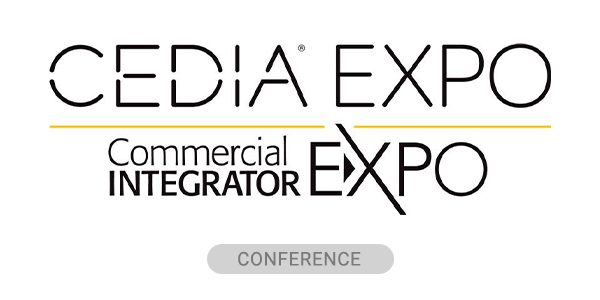Successful commercial integrators understand the need to deliver technology experiences that are better than those at home. The philosophy holds true in restaurants, sports bars, theaters, churches and now, at work. After years spending time in home offices that workers created to cater to their own preferences and comfort levels with technology, employees are demanding a customized, personalized experience in corporate boardrooms. Significantly, they expect an environment that raises the bar on the typical videoconference session. Fortunately, in-room control technology capabilities can meet these demands, creating a multi-camera, automated boardroom experience with high production values, all accomplished using products that operate seamlessly together.
“We need to provide some ‘wow factor’ to the system that we’re implementing, and it needs to provide a lot more value than what they have at home,” Steve Greenblatt, CTS, founder and president of Control Concepts Inc., says. Control Concepts is a provider of specialized software and services for the AV industry. “If someone feels they can do [the same thing] at home, they are going to say they don’t have to come to the office.”
Commercial Integrator sought the insights of Greenblatt, as well as Andrew Stanley, vice president of services at The Farm AV. Together, we discussed some of the advances and trends in room control that are poised to take us through the next decade of workplace connectivity, productivity and efficiency.
Download: Collaboration Today and Tomorrow: Fall 2023 Edition
Technology in Every Boardroom
Very rarely do you see a boardroom specified without AV and control, Stanley says, pointing to the first post-pandemic trend that emerged. “Coming out of the pandemic, we were kind of afraid that no one was going to go back to the office and there would be fewer conference rooms being built.” On the contrary, the hybrid-work model has brought increased demand for AV and control devices. “You still need a place to have meetings,” he says.
He adds that these rooms need to accommodate in-office participants and remote participants. “In the past, you might have rooms that were just meeting space,” he reflects. “Now, almost every room has to be outfitted with videoconferencing capabilities.”
Standardized, Easy-to-Use Solutions
Although clients have always expected a seamless, simple user experience, easy control becomes even more important when virtually every space — whether in a corporate facility or an education campus — now requires AV and control devices. This has generated considerable interest in products like the AV Controller Series from Legrand | AV brand C2G. Consolidated control from a single location, via an in-wall solution like the AV Controller, has become increasingly compelling for many integrators.
More broadly, Greenblatt encourages standardizing control systems, devices and interfaces to have a similar look, feel and operation, thus delivering a consistent experience across corporate or education campuses. “Anybody can go in any room and be very comfortable,” he says.
Related: Logic Integration Transforms Building into Tech Marvel: NexGen HQ
Integration with Unified Communications
More often than not, meeting spaces utilize UC platforms like Zoom, Google Meet or Microsoft Teams. When it comes to boardroom AV and room control, UC has changed everything, our experts declare.
“Those [platforms] are becoming the core of the system operation because that’s what everybody spends most of their time using,” Greenblatt says.
Initially, this presented challenges for integration businesses, as clients moved away from hardware-based videoconferencing and codecs and turned to UC platforms. Previously, Stanley recalls, separate control devices might be required for lighting, shades and temperature. You certainly couldn’t make these adjustments within your videoconferencing interface.
Today, the option exists for the room control system to operate within a separate tab or second screen on Zoom, Teams and Google Meet via a control system API. “Our clients can enjoy the experience of Zoom,” Stanley says. “But, when you tab over, you can turn the lights on, raise and lower shades, change the temperature or switch sources.”
Zoom — or your UC platform of choice — defers to the control system to provide seamless operation. “From the user-experience standpoint, they don’t know the difference,” Stanley says.
Greenblatt underscores that the “walled gardens” and “closed ecosystems” of the past are now opening up thanks to API integration. Regardless of the preferred control system, hardware, software and UC platforms can now operate seamlessly.
“They need to be interoperable,” Greenblatt says, “so a third-party product doesn’t just work with one control platform — it works with several.” He explains that this is another trend that has emerged since the pandemic.
Replicable Solutions
With open API integration so prevalent today, Greenblatt says that he is also seeing a trend toward replicable systems with field-configurable programming.
“Minor variations that exist from room to room do not require programming changes,” he says. “The result is a singular code set for a majority of the typical room types. We are seeing a desire to have fewer one-off, bespoke systems.” This, of course, aligns with our earlier point about standardization and consistency from space to space.
Production Quality Experiences
Maintaining consistency within a corporate building or education campus certainly does not mean today’s systems are boring or that they lack features. Employees’ demand for seamless experiences has led The Farm AV to push the envelope on what today’s control systems and devices can accomplish.
“Rather than that simple, one-camera shot [that is] looking down a boardroom table with six or eight people sitting there,” Stanley begins, “they want to have a better visual experience.” He notes that he’s been getting a lot of requests for multi-camera automation.
“During the pandemic, you were face to face with everybody,” Stanley points out. “Now, you go back to the conference room, and you can barely see if a person’s mouth is moving — let alone see their facial expressions.” He continues, “People have been trying to find a way to fill that gap.”
Automatic Camera Preset Recall
Stanley and Greenblatt both attest that they’re seeing more requests to marry microphone and camera solutions together via the control system. Automatic Camera Preset Recall, a feature offered in Q-SYS control systems, uses beam-forming microphones to pinpoint the person talking. The microphone then sends a signal to the control system, which triggers camera automation.
“Not only is the audio system able to single out the person who is speaking and filter out the background noise, but the camera system is also tracking,” Stanley explains.
Presenter Tracking
Integrators can take a visual approach to camera automation following Crestron’s acquisition of 1 Beyond. Data from the camera connected to a 1 Beyond processor is usable to track the presenter, even as they walk across the room. “It’s not using acoustic cues to recall presets,” Stanley explains. On the contrary, he says, “It’s using visual processing to identify and capture that person.”
Seervision, a Swiss company, works with Q-SYS control systems to deliver similar functionality. According to Stanley, “You can upload pictures of the CEO, and it will use [facial] detection to give someone priority or caption the images on the screen.”
By connecting the cameras in a conference room to either control system using these products, it’s also possible, when the cameras send the applicable signals, to turn on or dim spotlights, have lights follow presenters, or focus on a whiteboard or podium.
“The advantages are being able to frame a presenter as they walk around a room,” Stanley explains. “You can [also] create these exclusion and inclusion zones. If a person walks too far to the left, the camera’s not going to track them to that space. The camera will zoom back and give you a wide shot.”
Related: Crestron Updates Automate VX with Intelligent Facial & Torso Detection
Screen Equity
One thing that goes hand-in-hand with a production quality, almost-cinematic-feeling experience is the concept of screen equity. “There’s a feeling that, if you’re calling in remote, you’ve got a lot more screen time,” Stanley explains.
Stanley cites a recent boardroom installation, completed by The Farm AV, in which every seat had a 14-inch monitor and camera. “Everybody on the far side was able to see everybody’s face on the screen individually,” he recalls. “We’re seeing a lot of this push to get more advanced with the way we capture all the local participants.”
The same room uses additional cameras and microphones trained on a podium, whiteboard and each side of the table, as well as the CEO’s seat. Based on acoustic cues, the far-side view switches automatically to show the appropriate images.
AI Under the Hood
Further reflecting on the growing role of in-room control systems and devices in corporate boardrooms and on education campuses, Stanley says, “Everybody is asking for some level of automation.”
Although the control system, programming and peripheral technology all play a part, Stanley says that none of it would be possible without the recent advances in artificial intelligence. “It’s embedded in a lot of what’s happening now,” he comments, noting that AI helps route data across the network to maintain the quality of service behind the scenes.
“As service providers, we don’t typically interact with AI, but we see it in this level of automation,” he reflects. “We couldn’t be where we are today — the state of AV and control — without it.”
Dawn Allcot is owner, writer, editor and consultant at Allcot Media Inc.










